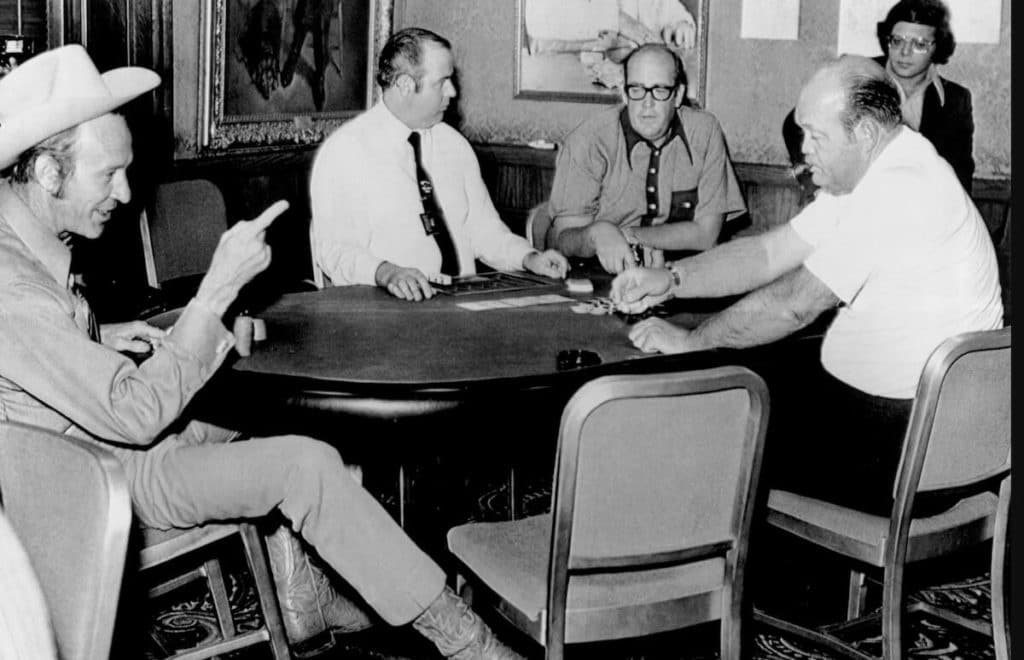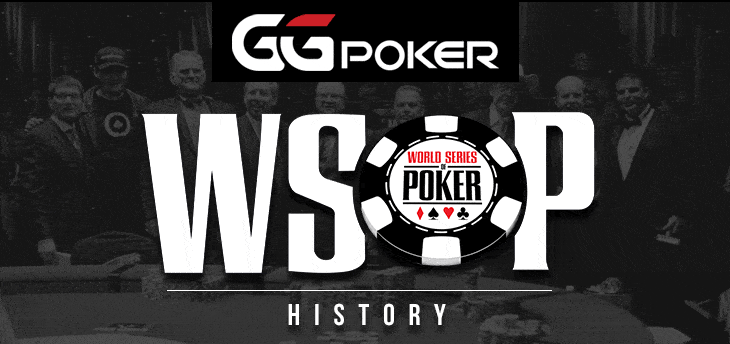The Story of the 1972 WSOP Main Event
In 1972, after two years of Johnny Moss winning the World Championship, a controversial deal was struck in the WSOP Main Event. Going down in history as the first ‘ICM’ deal at a final table, the winner was a controversial figure in his own right as one year on from six players competing for a silver cup and a world championship worth $30,000, Amarillo Slim went down in poker history as the best player in the world… at making a deal.
Zero Hype for Preliminary Event
In 1972, it was agreed that only one preliminary event would be played. As it happened, Benny Binion needn’t have bothered. Costing $10,000 to play, the event – such as it was – took place in the Limit Five-Card Stud format. Bill Boyd had won the 1971 WSOP event in Five-Card Stud and repeated his trick 12 months on – albeit with only one opponent. The unnamed challenger lost to Boyd and the reigning champion picked up just $10,000 profit on his own entry of the same amount.
All the talk ahead of the WSOP Main Event was of the inflated player pool. The previous year had featured six players and Benny Binion had worked hard at hyping up his Main Event to the extent that he hoped the field would double. In fact, Binion had offered to pay half of each player’s buy-in, raising it from $5,000 to $10,000, with players putting up the other $5,000 themselves.
Sadly for Binion, his plan, while successful in growing the field to eight players, didn’t lure the full dozen entrants he dreamed of from the cash game tables. As May 11th welcomed Main Event players, the cash games were thriving to such an extent that only eight men took their seats in the tournament.

Poker Legends of the Future
There was no way of knowing it at the time, but many of the players who assembled in May 1972 would go on to become some of the greatest poker legends, most making the Poker Hall of Fame. Once again, Johnny Moss took part, hoping to make it three in a row. Joining in the mix were returning players Jimmy Casella, Jack ‘Treetop’ Straus, Walter ‘Puggy’ Pearson, and Doyle Brunson. Crandell Addington, who played in the 1970 game, also joined, along with Thomas ‘Amarillo Slim’ Preston and an 8th player whose identity was not recorded.
Just as in 1971, the Main Event was ‘Winner Takes All’. Unlike the previous year, that was not to happen. The denouement of a Main Event that will never be forgotten was some way off when play got underway. Jimmy Casella was the first man to be eliminated, shortly followed by the unknown player. The previous two years had seen Johnny Moss crowned world champion; however, despite leading the event early on, The Grand Old Man of Poker hit bottom set with a pair of deuces on a 9-7-2 flop and moved all-in on the turn of a ten. Doyle Brunson, yet to be known as ‘Texas Dolly’, called with pocket aces and hit another on the river to reduce his friend Moss to a scattering of chips that were soon lost.
Jack ‘Treetop’ Straus wasn’t able to get any momentum going either, losing out in fifth place. With four players left, Amarillo Slim was down to just 2,000 chips but hit trip fives to bounce back and as Jack Binion allowed TV crews to pick up the story and film the final table, Crandell Addington was knocked out in fourth place.
Three men remained – Amarillo Slim, Doyle Brunson and Puggy Pearson. Both Brunson and Pearson were not happy about the TV crews being present. Their concerns weren’t only for tax reasons, but that was certainly a factor. With cash games likely to be packed with players who would know their faces if they were pronounced as a world champion on television, Amarillo Slim was the only player happy to carry on playing.

The Art of The Deal
With the trio locked in conversation, a controversial and pioneering deal was struck. Both Brunson and Pearson agreed to let Slim win but would take the chip values of their stacks out of Slim’s $80,000 top prize. When he found out the players’ plan, Benny Binion was initially livid. Speaking with Brunson in the Sombrero room at Binion’s Horseshoe, Binion conceded to one of his players’ wishes. Brunson was allowed to take home an unknown amount of money from the $80,000 prize pool.
Down to two players, Pearson had a change of heart and was not happy with the deal he had agreed and decided that he wanted to win the Main Event instead. Binion, having agreed to the deal for Brunson’s benefit, had a job on his hands to persuade ‘Puggy’ that he should throw the heads-up and let Slim take the title.
In the final hand, Pearson raised it up with pocket sixes and on a flop of K-8-8, called Slim’s shove. Amarillo Slim held king-jack and held through the turn of a deuce and another eight on the river, meaning he was the world champion.
Amid the chaos of a three-way deal that only postponed the advent of televised poker rather than extinguishing it, The Hendon Mob has it that Slim won only $15,000 while Pearson and Brunson chopped up the other $65,000. With all three poker legends having passed, it’s unlikely we’ll ever discover the truth.

Prior to any deal, ‘Amarillo Slim’, Doyle Brunson, and ‘Puggy’ Pearson ready to play as the final 3 at the final table of the 1972 World Series of Poker Main Event.
A Tainted Tale or Legendary Legacy?
To say that Amarillo Slim is a figure who divides opinion would be akin to saying that Phil Hellmuth likes to chat a little. After his victory in the 1972 World Series of Poker Main Event, he described the action as it happened with a flagrant disregard for any semblance of tact.
“Pearson was trying to win right up to the last 30 minutes. That’s when it happened. They knew they couldn’t get any publicity out of it if Doyle won it. That’s not putting Doyle down – Doyle just wasn’t a talker in those days. Puggy wouldn’t have been a good choice because about half the people he had screwed over the years were bound to say a few things. So, I was the pick for winning it.”
On the back of taking the title, Slim became the first-ever ‘poker celebrity’, appearing as a guest on The Tonight Show with Johnny Carson as well as a slew of other TV shows. Well regarded by many of his peers, Slim’s golden reputation may have been that of a gambler and raconteur, but he was spoken about with fondness. That was until he was accused of molesting his grandchild at the age of 77. Slim refuted the claims, but by pleading no contest to a ‘non-sexual assault’ in his own words to save his family the misery of attending court, his reputation was tainted in the eyes of many.
“I think there are a bunch of hypocrites in the poker world and a lot of them are obligated to me,” said Slim in the years that followed the accusations until his death six years later. “Not a one of them has showed up and stood beside me. I don’t hear from them anymore. Some of them could have said something and shown their support. But they didn’t.”
Amarillo Slim’s poker legacy might be tainted in the eyes of some, but it is a powerful one. Slim literally brought poker from the shady back rooms to the limelight in front of millions of potential players over the years via television appearances, something that no other player at the time was able to do.
A poker legend, Amarillo Slim was mourned by many when he died in 2012. His influence continues in the poker world to this day.

1971 WSOP Main Event 1973 WSOP Main Event
About the Author: Paul Seaton has written about poker for over 10 years, interviewing some of the best players ever to play the game such as Daniel Negreanu, Johnny Chan and Phil Hellmuth. Over the years, Paul has reported live from tournaments such as the World Series of Poker in Las Vegas and the European Poker Tour. He has also written for other poker brands where he was Head of Media, as well as BLUFF magazine, where he was Editor.

